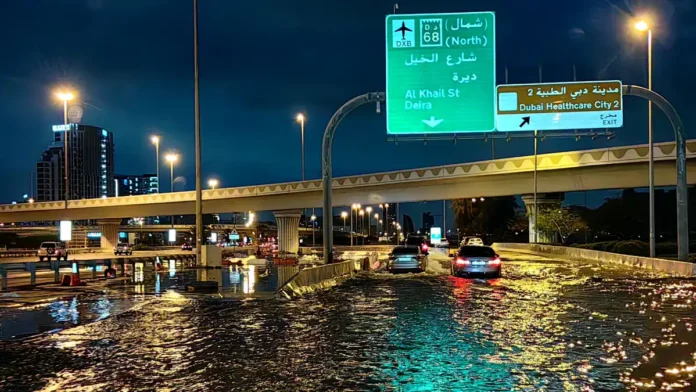Dubai Devastating ‘Desert Storm’ Global extreme weather events, particularly brief periods of intense rainfall, have become more frequent due to rising temperatures brought on by emissions caused by human activity. According to scientists, this is because a warmer atmosphere can retain more moisture over extended periods.
The world is baffled by this week’s record-breaking rainfall in Dubai. One of the fastest-growing cities in the world, noted for its towering skyscrapers and luxurious infrastructure, is located in the Arabian Desert. However, recent heavy rains have caused terrible floods, bringing the city to its knees.
The city saw 1.5 years’ worth of rain in a matter of hours, according to the United Arab Emirates (UAE) National Meteorological Centre. On Tuesday, the city of Al Ain recorded the largest amount of precipitation ever recorded—254 mm in less than a day.
According to meteorologists, a high-intensity storm that was sweeping through the area was what caused the rainfall; these systems migrated eastward from the Mediterranean Sea. This time, though, it stretched unusually far south.
GLOBAL WARMING FUELLED INTENSE STORM?
A mid-latitude westerly trough from the Mediterranean Sea developed to such a degree of strength that it also reached southward, into the United Arab Emirates. It generally affects areas even closer to Tibet, such as the upper regions of Afghanistan, Pakistan, Kashmir, Himachal Pradesh, and Uttarakhand, but it spread unusually far south. Thus, flooding in Oman and the neighboring Saudi Arabia preceded the rainfall in Dubai, according to Dr. KJ Ramesh, a former head of the India Meteorological Department (IMD).
Additional moisture from the Arabian Sea, which was also causing intense rains over Bahrain and Qatar, further fueled the storm.
However, it’s obvious that this is a recurring problem. Worldwide, there has been an increase in extreme weather events, particularly brief episodes of intense rain that have caused devastating floods.
The Earth is already over 1.1°C warmer due to the massive volumes of greenhouse gasses that human activity has pushed into the atmosphere.
“Heavy rainfall events have undoubtedly intensified due to global warming, regardless of the exact cause. Even if there are fewer rainy days overall, there is a noticeable increase in the amount of rainfall on those days. The senior atmospheric scientist continued, “This is because a warmer atmosphere can hold more moisture and sustain strong, deep clouds for a long duration, which leads to a sudden downpour.”
CLOUD SEEDING GONE WRONG?
Experts have also addressed the widespread debate over whether the existing rainfall event was inadvertently exacerbated by artificial cloud seeding. Dubai Devastating ‘Desert Storm’ This is a scientific method of modifying the weather by dispersing large salt particles into convective clouds through an aircraft to increase the overall precipitation. The UAE’s National Centre of Meteorology was one of the first in the Arabian Gulf region to use cloud seeding and has been using it for more than a decade to incrementally increase rainfall. This is done using a private airplane supplied by special salt flares manufactured to fit with the nature of the physical and chemical properties of the clouds that form in the UAE.
According to Professor Sachchida Nand Tripathi, from the Department of civil engineering at IIT Kanpur, who has also been associated with cloud seeding experiments in India, it is highly unlikely that the rainfall was triggered by such an exercise. One of the reasons is that artificial seeding is done during the early stages of cloud development. But if a storm is well-developed, seeding is usually not recommended.
“Globally, there is a general consensus among scientific agencies that cloud seeding can bring about a 15 to 25% increase in rainfall. So if we go by this data, it would have still rained heavily in Dubai. So, it is highly unlikely that the event could be attributed to seeding,” said Prof Tripathi. “Moreover, the objective of artificial seeding is to manually alter the natural development of the cloud to enhance precipitation. Many times we see in arid and semi-arid regions that clouds form, but they do not lead to enough rain, so this technology can be helpful.”
Several states in India including Andhra Pradesh and Tamil Nadu have also experimented with this technology for inducing rain in semi-arid regions.
Recently, the Indian Institute of Technology (IIT) Kanpur also completed trials using its seeding equipment and a fully-equipped aircraft and is planning to extend it soon.



Recent Comments